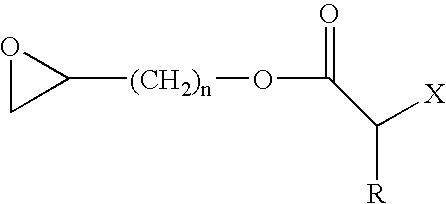Process for producing (meth)acrylic polymer terminated by crosslinkable silyl group
a technology of crosslinking silyl group and methacrylic polymer, which is applied in the field of process for producing (meth)acrylic polymer terminated by crosslinking silyl group, can solve the problems of degrading the quality of the resulting products, affecting and affecting the quality so as to improve the ability of the resulting product
- Summary
- Abstract
- Description
- Claims
- Application Information
AI Technical Summary
Benefits of technology
Problems solved by technology
Method used
Image
Examples
synthetic example 1
Polymerization of n-butyl Acrylate
[0161] In a reactor equipped with a stirrer, CuBr (4.2 parts) and acetonitrile (27.3 parts) were charged and stirred for 15 minutes at 65° C. in a nitrogen atmosphere. To the resulting mixture, n-butyl acrylate (100 parts), diethyl 2,5-dibromoadipate (8.8 parts), and acetonitrile (16.6 parts) were supplied, and the resulting mixture was thoroughly stirred. Pentamethyldiethylenetriamine (0.17 part) was fed to initiate polymerization. While the mixture was stirred under heating at 70° C., n-butyl acrylate (400 parts) was continuously added to the mixture dropwise. During the addition of the n-butyl acrylate, triamine (0.68 part) was added in portions.
Introduction of Alkenyl Groups to the (Meth)acrylic Polymer
[0162] When the monomer conversion rate reached 96%, the remaining monomer and acetonitrile were removed by evaporation at 80° C. 1,7-Octadiene (53.7 parts), acetonitrile (132 parts), and triamine (1.69 parts) were added to the reaction mixtu...
example 1
Addition of the Hydrosilane Compound (B) Having a Crosslinkable Silyl Group to the Alkenyl-Containing (Meth)acrylic Polymer (A)
[0167] Methyl orthoformate (3 molar equivalents per alkenyl group), a platinum catalyst (30 mg in terms of platinum metal per kilogram of the polymer), i.e., a xylene solution of a bis(1,3-divinyl-1,1,3,3-tetramethyldisiloxane) platinum complex, hereinafter simply referred to as “platinum catalyst”, and methyldimethoxysilane (3 molar equivalents per alkenyl group) were sequentially supplied in that order to the polymer obtained by Steps 1 and 2 described above. The resulting mixture was stirred under heating at 80° C. for 2 hours in a nitrogen atmosphere. Disappearance of the alkenyl groups by the reaction was confirmed by 1H-NMR. The reaction mixture was then concentrated to obtain a target polymer containing methoxysilyl groups. This polymer had a number-average molecular weight of 28,900 and a molecular weight distribution of 1.47. The number of silyl g...
synthetic example 2
Copolymerization of n-butyl Acrylate, Ethyl Acrylate, and 2-methoxyethyl Acrylate
[0170] In a reactor equipped with a stirrer, CuBr (4.6 parts) and acetonitrile (41.6 parts) were charged and stirred for 15 minutes at 65° C. in a nitrogen atmosphere. To the resulting mixture, acrylic esters (a total of 100 parts: n-butyl acrylate (27.6 parts), ethyl acrylate (39.8 parts), and 2-methoxyethyl acrylate (32.6 parts)), and diethyl 2,5-dibromoadipate (13.0 parts) were supplied. The resulting mixture was thoroughly stirred. Pentamethyldiethylenetriamine (hereinafter simply referred to as “triamine”, 0.09 part) was fed to the mixture to initiate polymerization. While the mixture was stirred under heating at 70° C., acrylic esters (a total of 400 parts: n-butyl acrylate (111 parts), ethyl acrylate (159 parts), and 2-methoxyethyl acrylate (130 parts)) were continuously added dropwise to the mixture. During the addition of the acrylic esters, triamine (0.84 part) was supplied in portions.
Int...
PUM
| Property | Measurement | Unit |
|---|---|---|
| temperature | aaaaa | aaaaa |
| temperature | aaaaa | aaaaa |
| temperature | aaaaa | aaaaa |
Abstract
Description
Claims
Application Information
 Login to View More
Login to View More - R&D
- Intellectual Property
- Life Sciences
- Materials
- Tech Scout
- Unparalleled Data Quality
- Higher Quality Content
- 60% Fewer Hallucinations
Browse by: Latest US Patents, China's latest patents, Technical Efficacy Thesaurus, Application Domain, Technology Topic, Popular Technical Reports.
© 2025 PatSnap. All rights reserved.Legal|Privacy policy|Modern Slavery Act Transparency Statement|Sitemap|About US| Contact US: help@patsnap.com



